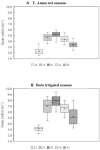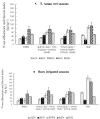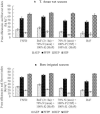Bio-Organic Fertilizer: A Green Technology to Reduce Synthetic N and P Fertilizer for Rice Production
- PMID: 33833767
- PMCID: PMC8023392
- DOI: 10.3389/fpls.2021.602052
Bio-Organic Fertilizer: A Green Technology to Reduce Synthetic N and P Fertilizer for Rice Production
Abstract
Decomposed organic materials, in combination with plant growth-promoting bacteria (PGPB), are environmentally friendly and reduce synthetic fertilizer use in rice production. A bio-organic fertilizer (BoF) was prepared using kitchen waste (79%), chita-dhan (unfilled rice grain) biochar (15%), rock phosphate (5%), and a consortium of 10 PGPB (1%) to supplement 30% nitrogen and to replace triple superphosphate (TSP) fertilizer in rice production with an improvement of soil health. PGPB were local isolates and identified using 16S ribosomal RNA partial gene sequences as Bacillus mycoides, Proteus sp., Bacillus cereus, Bacillus subtilis, Bacillus pumilus, Paenibacillus polymyxa, and Paenibacillus spp. Isolates could fix N2 by 0.7-1.4 g kg-1, solubilize 0.1-1.2 g kg-1 phosphate, and produce 0.1-40 g kg-1 indoleacetic acid. The performance of BoF was evaluated by 16 field experiments and 18 farmers' field demonstration trials during the year 2017-2020 in different parts of Bangladesh. Performances of BoF were evaluated based on control (T1), full synthetic fertilizer dose of N, P, and K (T2), BoF (2 t ha-1) + 70% N as urea + 100% K as muriate of potash (T3), 70% N as urea + 100% P as TSP + 100% K as muriate of potash (T4), and 2 t ha-1 BoF (T5) treatments. At the research station, average grain yield improved by 10-13% in T3 compared with T2 treatment. Depending on seasons, higher agronomic N use efficiency (19-30%), physiological N use efficiency (8-18%), partial factor productivity (PFP)N (114-150%), recovery efficiency (RE)N (3-31%), N harvest index (HIN) (14-24%), agronomic P use efficiency (22-25%), partial factor productivity of P (9-12%), AREP (15-23%), and HIP (3-6%) were obtained in T3 compared with T2 treatment. Research results were reflected in farmers' field, and significant (P < 0.05) higher plant height, tiller, panicle, grain yield, partial factor productivity of N and P were obtained in the same treatment. Application of BoF improved soil organic carbon by 6-13%, along with an increased number of PGPB as compared with full synthetic fertilizer dose. In conclusion, tested BoF can be considered as a green technology to reduce 30% synthetic N and 100% TSP requirements in rice production with improved soil health.
Keywords: biochar; free-living N2 fixing bacteria; indoleacetic acid; kitchen waste; nitrogen use efficiency; phosphate solubilizing bacteria; phosphorus use efficiency.
Copyright © 2021 Naher, Biswas, Maniruzzaman, Khan, Sarkar, Jahan, Hera, Hossain, Islam, Islam and Kabir.
Conflict of interest statement
The authors declare that the research was conducted in the absence of any commercial or financial relationships that could be construed as a potential conflict of interest.
Figures




Similar articles
-
[Effects of the substitution of inorganic nitrogen by organic nitrogen fertilizer on maize grain yield and water and nitrogen use efficiency under plastic film fully mulched ridge-furrow in semi-arid area].Ying Yong Sheng Tai Xue Bao. 2019 Apr;30(4):1199-1206. doi: 10.13287/j.1001-9332.201904.025. Ying Yong Sheng Tai Xue Bao. 2019. PMID: 30994280 Chinese.
-
Manure combined with chemical fertilizer increases rice productivity by improving soil health, post-anthesis biomass yield, and nitrogen metabolism.PLoS One. 2020 Oct 7;15(10):e0238934. doi: 10.1371/journal.pone.0238934. eCollection 2020. PLoS One. 2020. PMID: 33027309 Free PMC article.
-
Combined application of bio-organic phosphate and phosphorus solubilizing bacteria (Bacillus strain MWT 14) improve the performance of bread wheat with low fertilizer input under an arid climate.Braz J Microbiol. 2018 Nov;49 Suppl 1(Suppl 1):15-24. doi: 10.1016/j.bjm.2017.11.005. Epub 2018 Apr 24. Braz J Microbiol. 2018. PMID: 29728340 Free PMC article.
-
Plant Growth-Promoting Bacteria as an Emerging Tool to Manage Bacterial Rice Pathogens.Microorganisms. 2021 Mar 26;9(4):682. doi: 10.3390/microorganisms9040682. Microorganisms. 2021. PMID: 33810209 Free PMC article. Review.
-
Inorganic fertilizer use and its association with rice yield gaps in sub-Saharan Africa.Glob Food Sec. 2023 Sep;38:100708. doi: 10.1016/j.gfs.2023.100708. Glob Food Sec. 2023. PMID: 37752897 Free PMC article. Review.
Cited by
-
"Harnessing the power of soil microbes: Their dual impact in integrated nutrient management and mediating climate stress for sustainable rice crop production" A systematic review.Heliyon. 2024 Dec 12;11(1):e41158. doi: 10.1016/j.heliyon.2024.e41158. eCollection 2025 Jan 15. Heliyon. 2024. PMID: 39758363 Free PMC article.
-
Determining the Effects of Compost Substitution on Carbon Sequestration, Greenhouse Gas Emission, Soil Microbial Community Changes, and Crop Yield in a Wheat Field.Life (Basel). 2022 Sep 5;12(9):1382. doi: 10.3390/life12091382. Life (Basel). 2022. PMID: 36143418 Free PMC article.
-
Soil fungal community is more sensitive than bacterial community to modified materials application in saline-alkali land of Hetao Plain.Front Microbiol. 2024 Feb 5;15:1255536. doi: 10.3389/fmicb.2024.1255536. eCollection 2024. Front Microbiol. 2024. PMID: 38374915 Free PMC article.
-
Chemical fertilizer reduction combined with bio-organic fertilizers increases cauliflower yield via regulation of soil biochemical properties and bacterial communities in Northwest China.Front Microbiol. 2022 Jul 27;13:922149. doi: 10.3389/fmicb.2022.922149. eCollection 2022. Front Microbiol. 2022. PMID: 35966650 Free PMC article.
-
An Insight into Microbial Inoculants for Bioconversion of Waste Biomass into Sustainable "Bio-Organic" Fertilizers: A Bibliometric Analysis and Systematic Literature Review.Int J Mol Sci. 2022 Oct 27;23(21):13049. doi: 10.3390/ijms232113049. Int J Mol Sci. 2022. PMID: 36361844 Free PMC article.
References
-
- Ahemad M., Kibret M. (2014). Mechanisms and applications of plant growth promoting rhizobacteria: current perspective. J. King Saud Univ.-Sci. 26 1–20. 10.1016/j.jksus.2013.05.001 - DOI
-
- Akintokun A., Ezaka E., Akintokun P., Shittu O., Taiwo L. (2019). Isolation, Screening and Response of Maize to Plant Growth Promoting Rhizobacteria Inoculants. Sci. Agricult. Bohemica 50 181–190. 10.2478/sab-2019-0025 - DOI
-
- Baligar V., Fageria N., He Z. (2001). Nutrient use efficiency in plants. Commun. Soil Sci. Plant Anal. 32 921–950.
-
- Battye W., Aneja V. P., Schlesinger W. H. (2017). Is nitrogen the next carbon? Earth’s Fut. 5 894–904. 10.1002/2017ef000592 - DOI
LinkOut - more resources
Full Text Sources
Other Literature Sources
Research Materials
Miscellaneous

